Purpose Of Different HRm Functions Assignment
VerifiedAdded on 2021/02/19
|13
|3077
|23
AI Summary
Contribute Materials
Your contribution can guide someone’s learning journey. Share your
documents today.
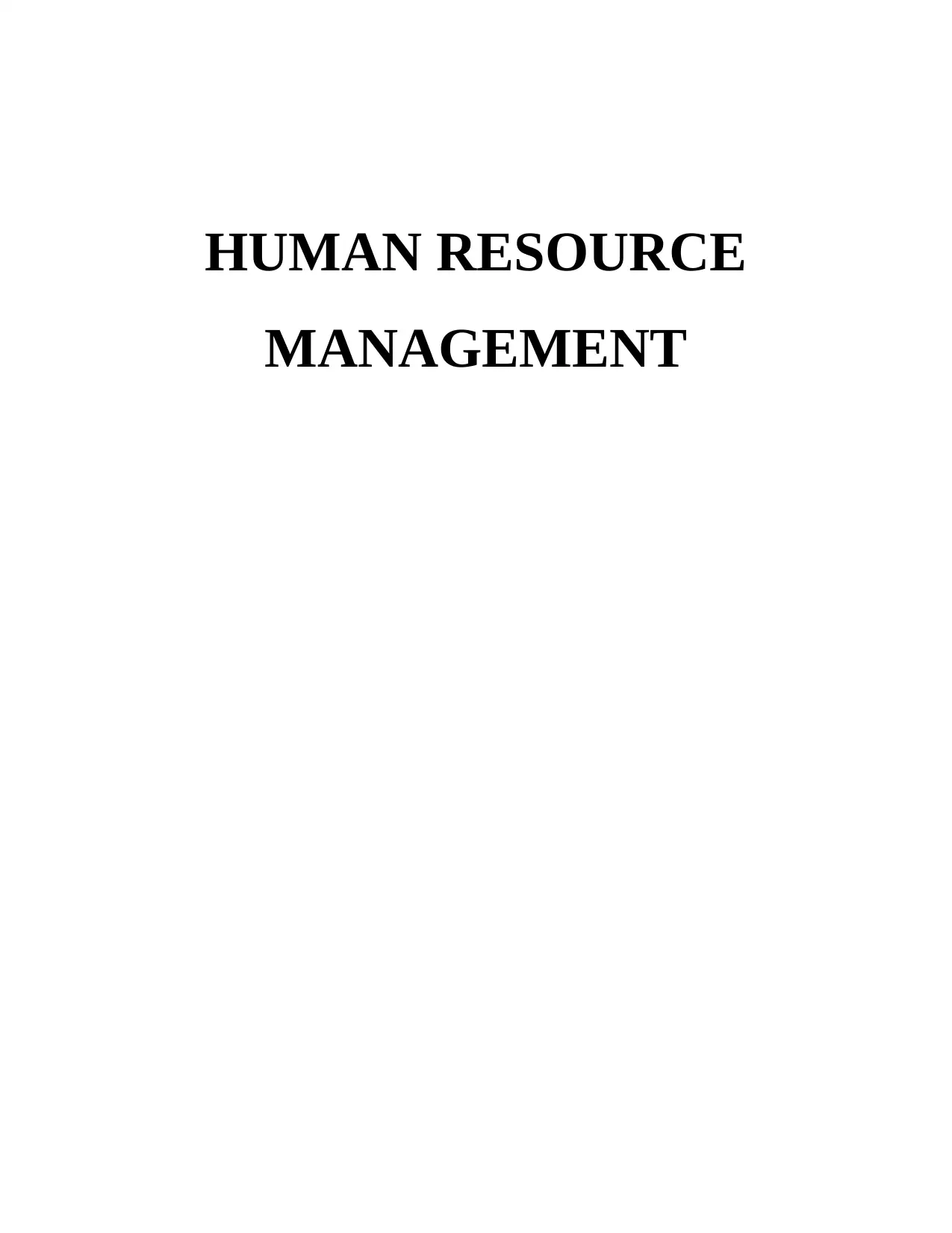
HUMAN RESOURCE
MANAGEMENT
MANAGEMENT
Secure Best Marks with AI Grader
Need help grading? Try our AI Grader for instant feedback on your assignments.
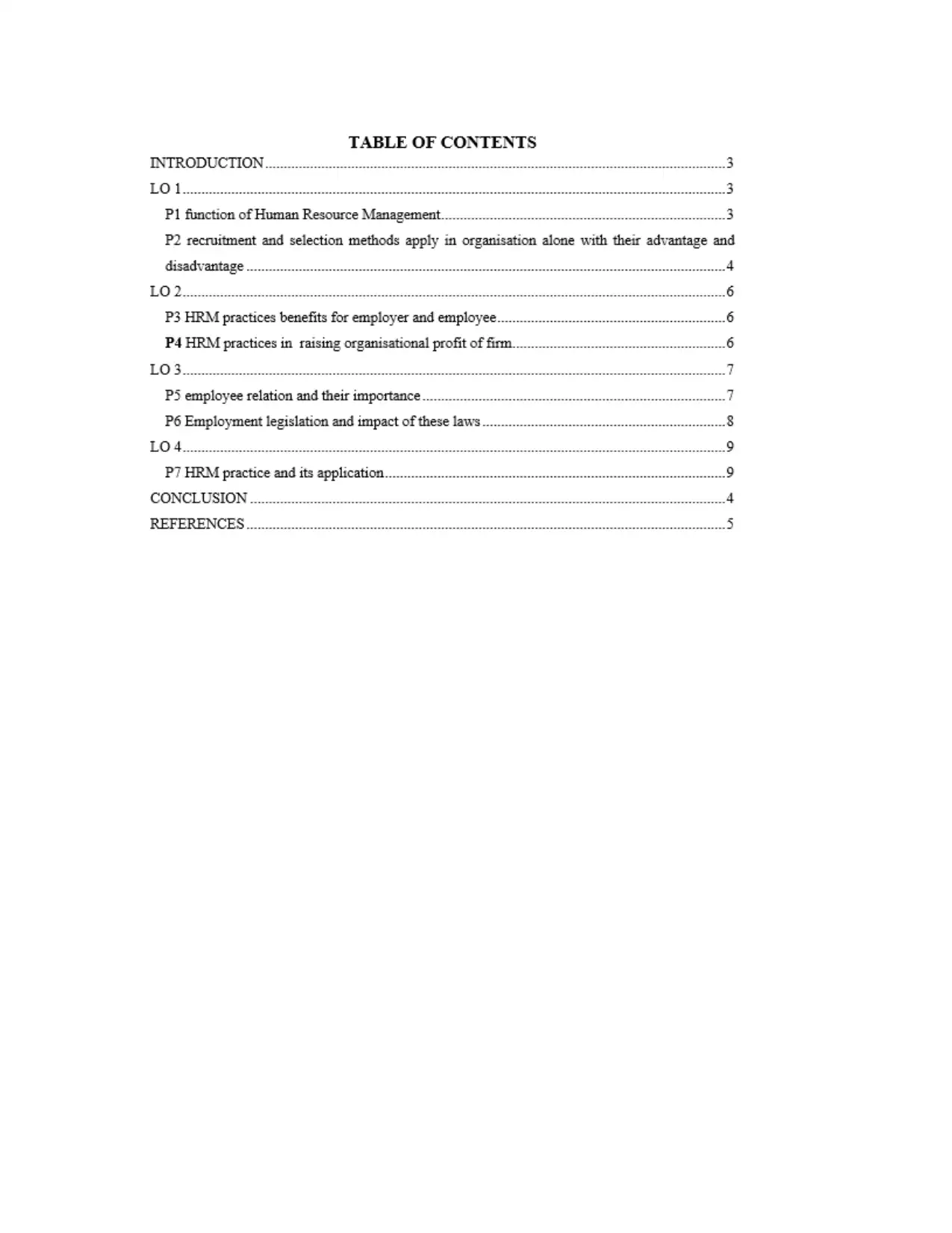
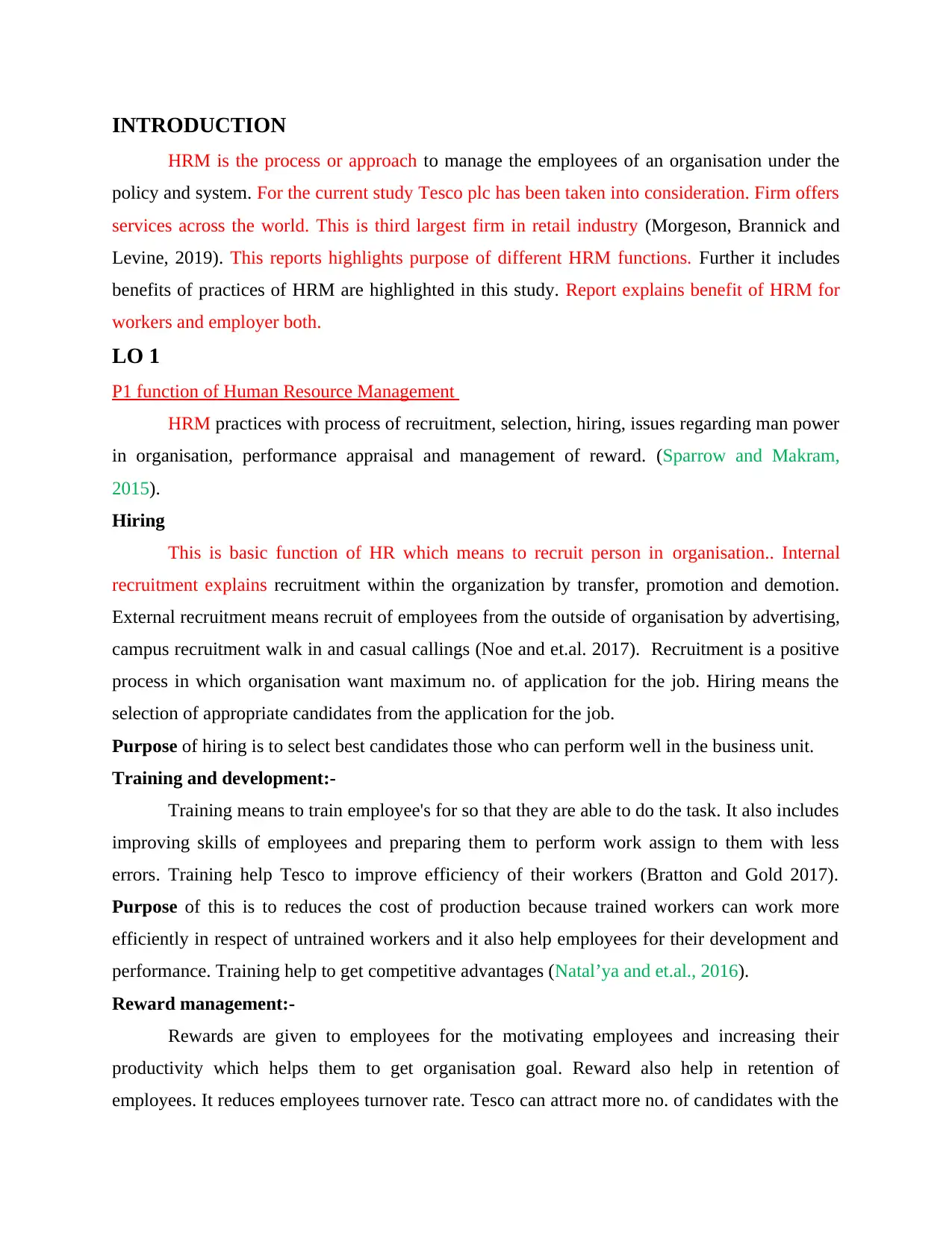
INTRODUCTION
HRM is the process or approach to manage the employees of an organisation under the
policy and system. For the current study Tesco plc has been taken into consideration. Firm offers
services across the world. This is third largest firm in retail industry (Morgeson, Brannick and
Levine, 2019). This reports highlights purpose of different HRM functions. Further it includes
benefits of practices of HRM are highlighted in this study. Report explains benefit of HRM for
workers and employer both.
LO 1
P1 function of Human Resource Management
HRM practices with process of recruitment, selection, hiring, issues regarding man power
in organisation, performance appraisal and management of reward. (Sparrow and Makram,
2015).
Hiring
This is basic function of HR which means to recruit person in organisation.. Internal
recruitment explains recruitment within the organization by transfer, promotion and demotion.
External recruitment means recruit of employees from the outside of organisation by advertising,
campus recruitment walk in and casual callings (Noe and et.al. 2017). Recruitment is a positive
process in which organisation want maximum no. of application for the job. Hiring means the
selection of appropriate candidates from the application for the job.
Purpose of hiring is to select best candidates those who can perform well in the business unit.
Training and development:-
Training means to train employee's for so that they are able to do the task. It also includes
improving skills of employees and preparing them to perform work assign to them with less
errors. Training help Tesco to improve efficiency of their workers (Bratton and Gold 2017).
Purpose of this is to reduces the cost of production because trained workers can work more
efficiently in respect of untrained workers and it also help employees for their development and
performance. Training help to get competitive advantages (Natal’ya and et.al., 2016).
Reward management:-
Rewards are given to employees for the motivating employees and increasing their
productivity which helps them to get organisation goal. Reward also help in retention of
employees. It reduces employees turnover rate. Tesco can attract more no. of candidates with the
HRM is the process or approach to manage the employees of an organisation under the
policy and system. For the current study Tesco plc has been taken into consideration. Firm offers
services across the world. This is third largest firm in retail industry (Morgeson, Brannick and
Levine, 2019). This reports highlights purpose of different HRM functions. Further it includes
benefits of practices of HRM are highlighted in this study. Report explains benefit of HRM for
workers and employer both.
LO 1
P1 function of Human Resource Management
HRM practices with process of recruitment, selection, hiring, issues regarding man power
in organisation, performance appraisal and management of reward. (Sparrow and Makram,
2015).
Hiring
This is basic function of HR which means to recruit person in organisation.. Internal
recruitment explains recruitment within the organization by transfer, promotion and demotion.
External recruitment means recruit of employees from the outside of organisation by advertising,
campus recruitment walk in and casual callings (Noe and et.al. 2017). Recruitment is a positive
process in which organisation want maximum no. of application for the job. Hiring means the
selection of appropriate candidates from the application for the job.
Purpose of hiring is to select best candidates those who can perform well in the business unit.
Training and development:-
Training means to train employee's for so that they are able to do the task. It also includes
improving skills of employees and preparing them to perform work assign to them with less
errors. Training help Tesco to improve efficiency of their workers (Bratton and Gold 2017).
Purpose of this is to reduces the cost of production because trained workers can work more
efficiently in respect of untrained workers and it also help employees for their development and
performance. Training help to get competitive advantages (Natal’ya and et.al., 2016).
Reward management:-
Rewards are given to employees for the motivating employees and increasing their
productivity which helps them to get organisation goal. Reward also help in retention of
employees. It reduces employees turnover rate. Tesco can attract more no. of candidates with the
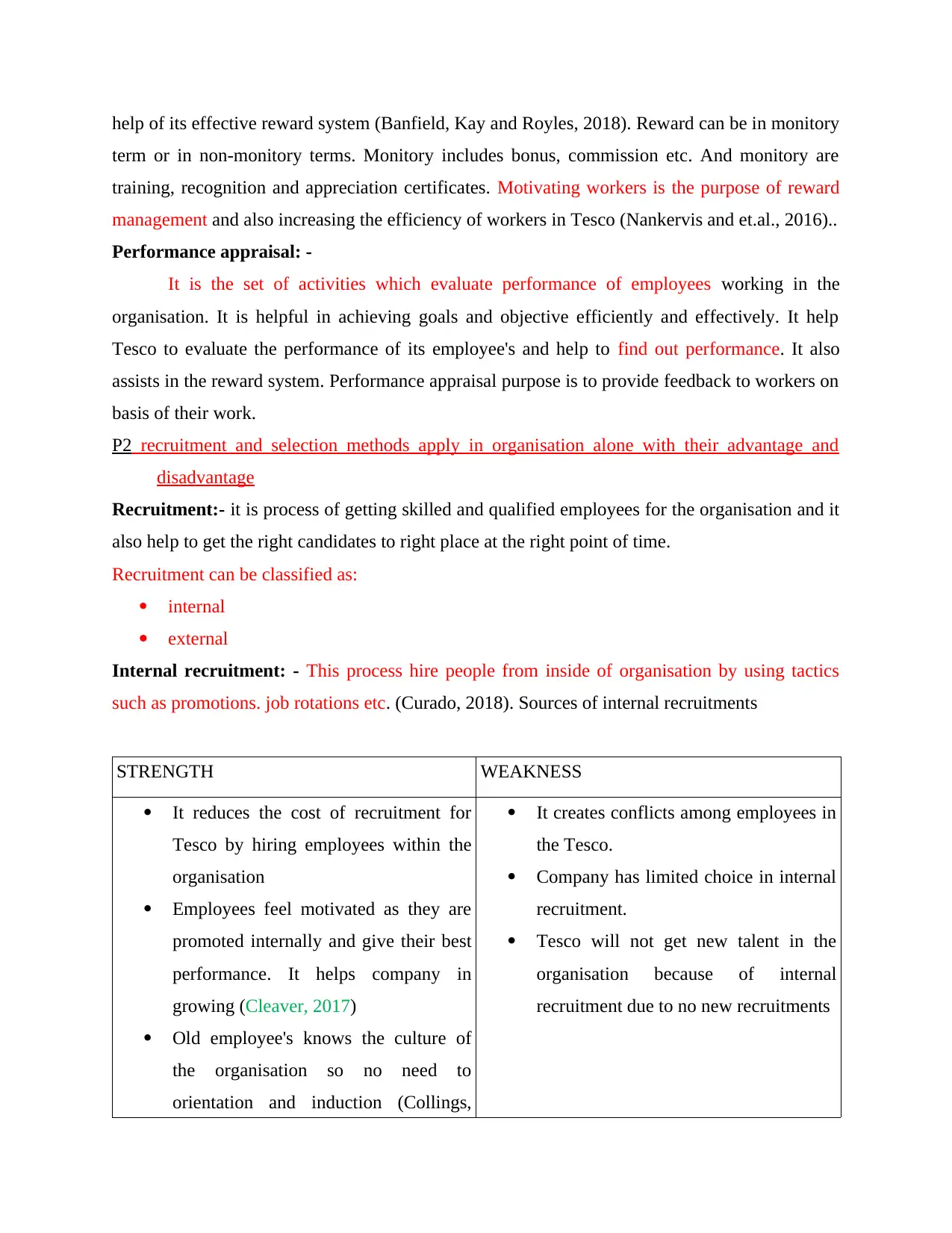
help of its effective reward system (Banfield, Kay and Royles, 2018). Reward can be in monitory
term or in non-monitory terms. Monitory includes bonus, commission etc. And monitory are
training, recognition and appreciation certificates. Motivating workers is the purpose of reward
management and also increasing the efficiency of workers in Tesco (Nankervis and et.al., 2016)..
Performance appraisal: -
It is the set of activities which evaluate performance of employees working in the
organisation. It is helpful in achieving goals and objective efficiently and effectively. It help
Tesco to evaluate the performance of its employee's and help to find out performance. It also
assists in the reward system. Performance appraisal purpose is to provide feedback to workers on
basis of their work.
P2 recruitment and selection methods apply in organisation alone with their advantage and
disadvantage
Recruitment:- it is process of getting skilled and qualified employees for the organisation and it
also help to get the right candidates to right place at the right point of time.
Recruitment can be classified as:
internal
external
Internal recruitment: - This process hire people from inside of organisation by using tactics
such as promotions. job rotations etc. (Curado, 2018). Sources of internal recruitments
STRENGTH WEAKNESS
It reduces the cost of recruitment for
Tesco by hiring employees within the
organisation
Employees feel motivated as they are
promoted internally and give their best
performance. It helps company in
growing (Cleaver, 2017)
Old employee's knows the culture of
the organisation so no need to
orientation and induction (Collings,
It creates conflicts among employees in
the Tesco.
Company has limited choice in internal
recruitment.
Tesco will not get new talent in the
organisation because of internal
recruitment due to no new recruitments
term or in non-monitory terms. Monitory includes bonus, commission etc. And monitory are
training, recognition and appreciation certificates. Motivating workers is the purpose of reward
management and also increasing the efficiency of workers in Tesco (Nankervis and et.al., 2016)..
Performance appraisal: -
It is the set of activities which evaluate performance of employees working in the
organisation. It is helpful in achieving goals and objective efficiently and effectively. It help
Tesco to evaluate the performance of its employee's and help to find out performance. It also
assists in the reward system. Performance appraisal purpose is to provide feedback to workers on
basis of their work.
P2 recruitment and selection methods apply in organisation alone with their advantage and
disadvantage
Recruitment:- it is process of getting skilled and qualified employees for the organisation and it
also help to get the right candidates to right place at the right point of time.
Recruitment can be classified as:
internal
external
Internal recruitment: - This process hire people from inside of organisation by using tactics
such as promotions. job rotations etc. (Curado, 2018). Sources of internal recruitments
STRENGTH WEAKNESS
It reduces the cost of recruitment for
Tesco by hiring employees within the
organisation
Employees feel motivated as they are
promoted internally and give their best
performance. It helps company in
growing (Cleaver, 2017)
Old employee's knows the culture of
the organisation so no need to
orientation and induction (Collings,
It creates conflicts among employees in
the Tesco.
Company has limited choice in internal
recruitment.
Tesco will not get new talent in the
organisation because of internal
recruitment due to no new recruitments
Secure Best Marks with AI Grader
Need help grading? Try our AI Grader for instant feedback on your assignments.
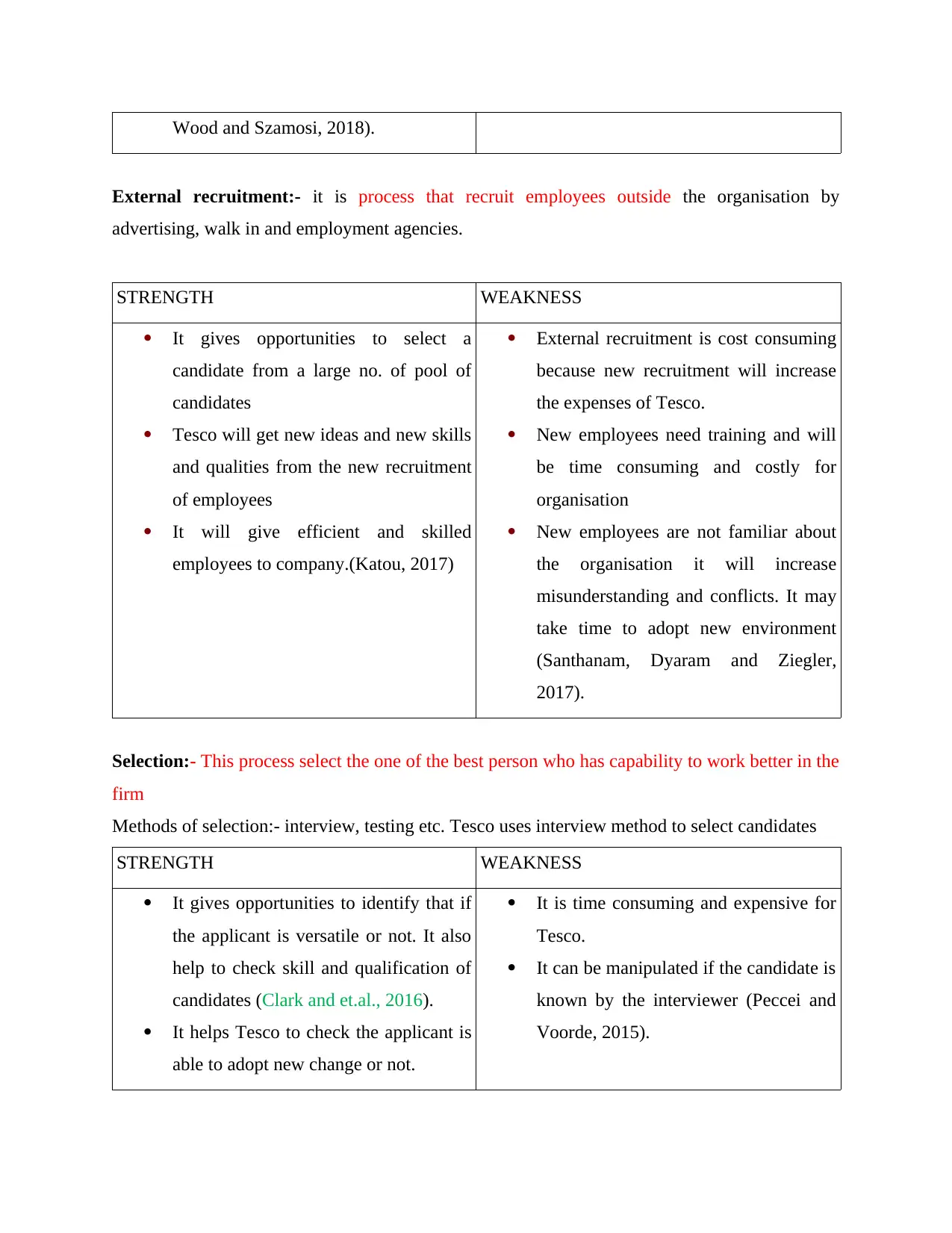
Wood and Szamosi, 2018).
External recruitment:- it is process that recruit employees outside the organisation by
advertising, walk in and employment agencies.
STRENGTH WEAKNESS
It gives opportunities to select a
candidate from a large no. of pool of
candidates
Tesco will get new ideas and new skills
and qualities from the new recruitment
of employees
It will give efficient and skilled
employees to company.(Katou, 2017)
External recruitment is cost consuming
because new recruitment will increase
the expenses of Tesco.
New employees need training and will
be time consuming and costly for
organisation
New employees are not familiar about
the organisation it will increase
misunderstanding and conflicts. It may
take time to adopt new environment
(Santhanam, Dyaram and Ziegler,
2017).
Selection:- This process select the one of the best person who has capability to work better in the
firm
Methods of selection:- interview, testing etc. Tesco uses interview method to select candidates
STRENGTH WEAKNESS
It gives opportunities to identify that if
the applicant is versatile or not. It also
help to check skill and qualification of
candidates (Clark and et.al., 2016).
It helps Tesco to check the applicant is
able to adopt new change or not.
It is time consuming and expensive for
Tesco.
It can be manipulated if the candidate is
known by the interviewer (Peccei and
Voorde, 2015).
External recruitment:- it is process that recruit employees outside the organisation by
advertising, walk in and employment agencies.
STRENGTH WEAKNESS
It gives opportunities to select a
candidate from a large no. of pool of
candidates
Tesco will get new ideas and new skills
and qualities from the new recruitment
of employees
It will give efficient and skilled
employees to company.(Katou, 2017)
External recruitment is cost consuming
because new recruitment will increase
the expenses of Tesco.
New employees need training and will
be time consuming and costly for
organisation
New employees are not familiar about
the organisation it will increase
misunderstanding and conflicts. It may
take time to adopt new environment
(Santhanam, Dyaram and Ziegler,
2017).
Selection:- This process select the one of the best person who has capability to work better in the
firm
Methods of selection:- interview, testing etc. Tesco uses interview method to select candidates
STRENGTH WEAKNESS
It gives opportunities to identify that if
the applicant is versatile or not. It also
help to check skill and qualification of
candidates (Clark and et.al., 2016).
It helps Tesco to check the applicant is
able to adopt new change or not.
It is time consuming and expensive for
Tesco.
It can be manipulated if the candidate is
known by the interviewer (Peccei and
Voorde, 2015).
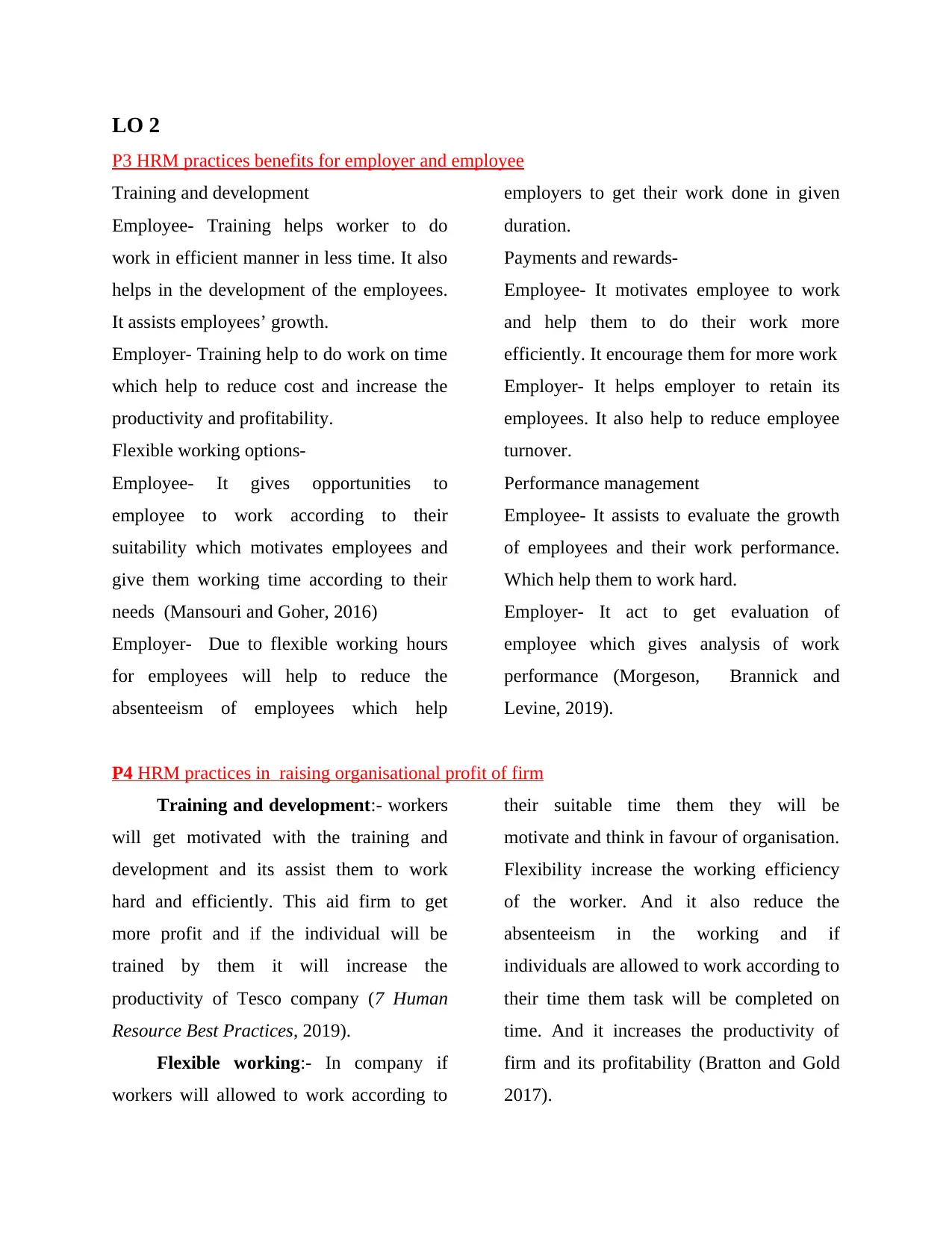
LO 2
P3 HRM practices benefits for employer and employee
Training and development
Employee- Training helps worker to do
work in efficient manner in less time. It also
helps in the development of the employees.
It assists employees’ growth.
Employer- Training help to do work on time
which help to reduce cost and increase the
productivity and profitability.
Flexible working options-
Employee- It gives opportunities to
employee to work according to their
suitability which motivates employees and
give them working time according to their
needs (Mansouri and Goher, 2016)
Employer- Due to flexible working hours
for employees will help to reduce the
absenteeism of employees which help
employers to get their work done in given
duration.
Payments and rewards-
Employee- It motivates employee to work
and help them to do their work more
efficiently. It encourage them for more work
Employer- It helps employer to retain its
employees. It also help to reduce employee
turnover.
Performance management
Employee- It assists to evaluate the growth
of employees and their work performance.
Which help them to work hard.
Employer- It act to get evaluation of
employee which gives analysis of work
performance (Morgeson, Brannick and
Levine, 2019).
P4 HRM practices in raising organisational profit of firm
Training and development:- workers
will get motivated with the training and
development and its assist them to work
hard and efficiently. This aid firm to get
more profit and if the individual will be
trained by them it will increase the
productivity of Tesco company (7 Human
Resource Best Practices, 2019).
Flexible working:- In company if
workers will allowed to work according to
their suitable time them they will be
motivate and think in favour of organisation.
Flexibility increase the working efficiency
of the worker. And it also reduce the
absenteeism in the working and if
individuals are allowed to work according to
their time them task will be completed on
time. And it increases the productivity of
firm and its profitability (Bratton and Gold
2017).
P3 HRM practices benefits for employer and employee
Training and development
Employee- Training helps worker to do
work in efficient manner in less time. It also
helps in the development of the employees.
It assists employees’ growth.
Employer- Training help to do work on time
which help to reduce cost and increase the
productivity and profitability.
Flexible working options-
Employee- It gives opportunities to
employee to work according to their
suitability which motivates employees and
give them working time according to their
needs (Mansouri and Goher, 2016)
Employer- Due to flexible working hours
for employees will help to reduce the
absenteeism of employees which help
employers to get their work done in given
duration.
Payments and rewards-
Employee- It motivates employee to work
and help them to do their work more
efficiently. It encourage them for more work
Employer- It helps employer to retain its
employees. It also help to reduce employee
turnover.
Performance management
Employee- It assists to evaluate the growth
of employees and their work performance.
Which help them to work hard.
Employer- It act to get evaluation of
employee which gives analysis of work
performance (Morgeson, Brannick and
Levine, 2019).
P4 HRM practices in raising organisational profit of firm
Training and development:- workers
will get motivated with the training and
development and its assist them to work
hard and efficiently. This aid firm to get
more profit and if the individual will be
trained by them it will increase the
productivity of Tesco company (7 Human
Resource Best Practices, 2019).
Flexible working:- In company if
workers will allowed to work according to
their suitable time them they will be
motivate and think in favour of organisation.
Flexibility increase the working efficiency
of the worker. And it also reduce the
absenteeism in the working and if
individuals are allowed to work according to
their time them task will be completed on
time. And it increases the productivity of
firm and its profitability (Bratton and Gold
2017).
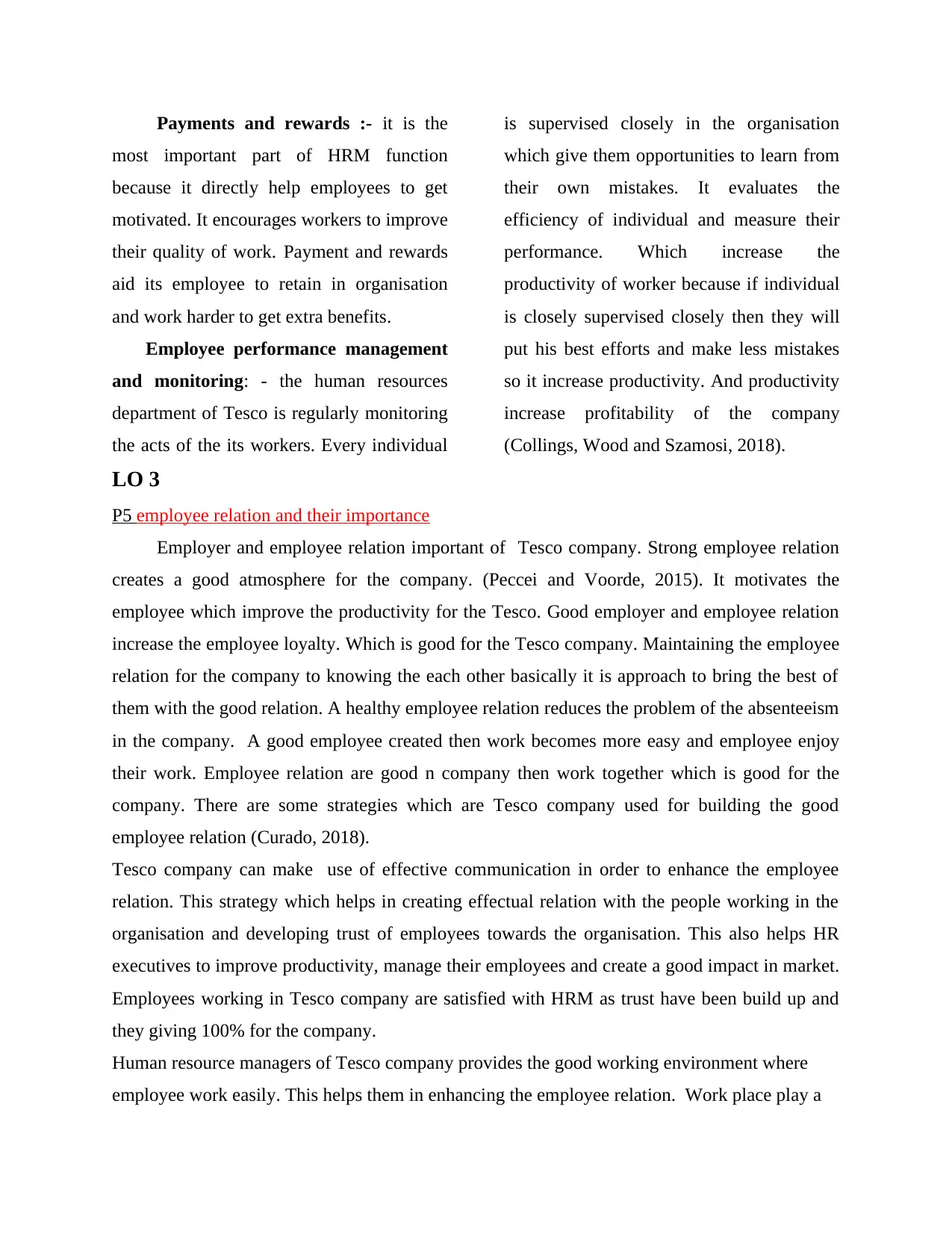
Payments and rewards :- it is the
most important part of HRM function
because it directly help employees to get
motivated. It encourages workers to improve
their quality of work. Payment and rewards
aid its employee to retain in organisation
and work harder to get extra benefits.
Employee performance management
and monitoring: - the human resources
department of Tesco is regularly monitoring
the acts of the its workers. Every individual
is supervised closely in the organisation
which give them opportunities to learn from
their own mistakes. It evaluates the
efficiency of individual and measure their
performance. Which increase the
productivity of worker because if individual
is closely supervised closely then they will
put his best efforts and make less mistakes
so it increase productivity. And productivity
increase profitability of the company
(Collings, Wood and Szamosi, 2018).
LO 3
P5 employee relation and their importance
Employer and employee relation important of Tesco company. Strong employee relation
creates a good atmosphere for the company. (Peccei and Voorde, 2015). It motivates the
employee which improve the productivity for the Tesco. Good employer and employee relation
increase the employee loyalty. Which is good for the Tesco company. Maintaining the employee
relation for the company to knowing the each other basically it is approach to bring the best of
them with the good relation. A healthy employee relation reduces the problem of the absenteeism
in the company. A good employee created then work becomes more easy and employee enjoy
their work. Employee relation are good n company then work together which is good for the
company. There are some strategies which are Tesco company used for building the good
employee relation (Curado, 2018).
Tesco company can make use of effective communication in order to enhance the employee
relation. This strategy which helps in creating effectual relation with the people working in the
organisation and developing trust of employees towards the organisation. This also helps HR
executives to improve productivity, manage their employees and create a good impact in market.
Employees working in Tesco company are satisfied with HRM as trust have been build up and
they giving 100% for the company.
Human resource managers of Tesco company provides the good working environment where
employee work easily. This helps them in enhancing the employee relation. Work place play a
most important part of HRM function
because it directly help employees to get
motivated. It encourages workers to improve
their quality of work. Payment and rewards
aid its employee to retain in organisation
and work harder to get extra benefits.
Employee performance management
and monitoring: - the human resources
department of Tesco is regularly monitoring
the acts of the its workers. Every individual
is supervised closely in the organisation
which give them opportunities to learn from
their own mistakes. It evaluates the
efficiency of individual and measure their
performance. Which increase the
productivity of worker because if individual
is closely supervised closely then they will
put his best efforts and make less mistakes
so it increase productivity. And productivity
increase profitability of the company
(Collings, Wood and Szamosi, 2018).
LO 3
P5 employee relation and their importance
Employer and employee relation important of Tesco company. Strong employee relation
creates a good atmosphere for the company. (Peccei and Voorde, 2015). It motivates the
employee which improve the productivity for the Tesco. Good employer and employee relation
increase the employee loyalty. Which is good for the Tesco company. Maintaining the employee
relation for the company to knowing the each other basically it is approach to bring the best of
them with the good relation. A healthy employee relation reduces the problem of the absenteeism
in the company. A good employee created then work becomes more easy and employee enjoy
their work. Employee relation are good n company then work together which is good for the
company. There are some strategies which are Tesco company used for building the good
employee relation (Curado, 2018).
Tesco company can make use of effective communication in order to enhance the employee
relation. This strategy which helps in creating effectual relation with the people working in the
organisation and developing trust of employees towards the organisation. This also helps HR
executives to improve productivity, manage their employees and create a good impact in market.
Employees working in Tesco company are satisfied with HRM as trust have been build up and
they giving 100% for the company.
Human resource managers of Tesco company provides the good working environment where
employee work easily. This helps them in enhancing the employee relation. Work place play a
Paraphrase This Document
Need a fresh take? Get an instant paraphrase of this document with our AI Paraphraser
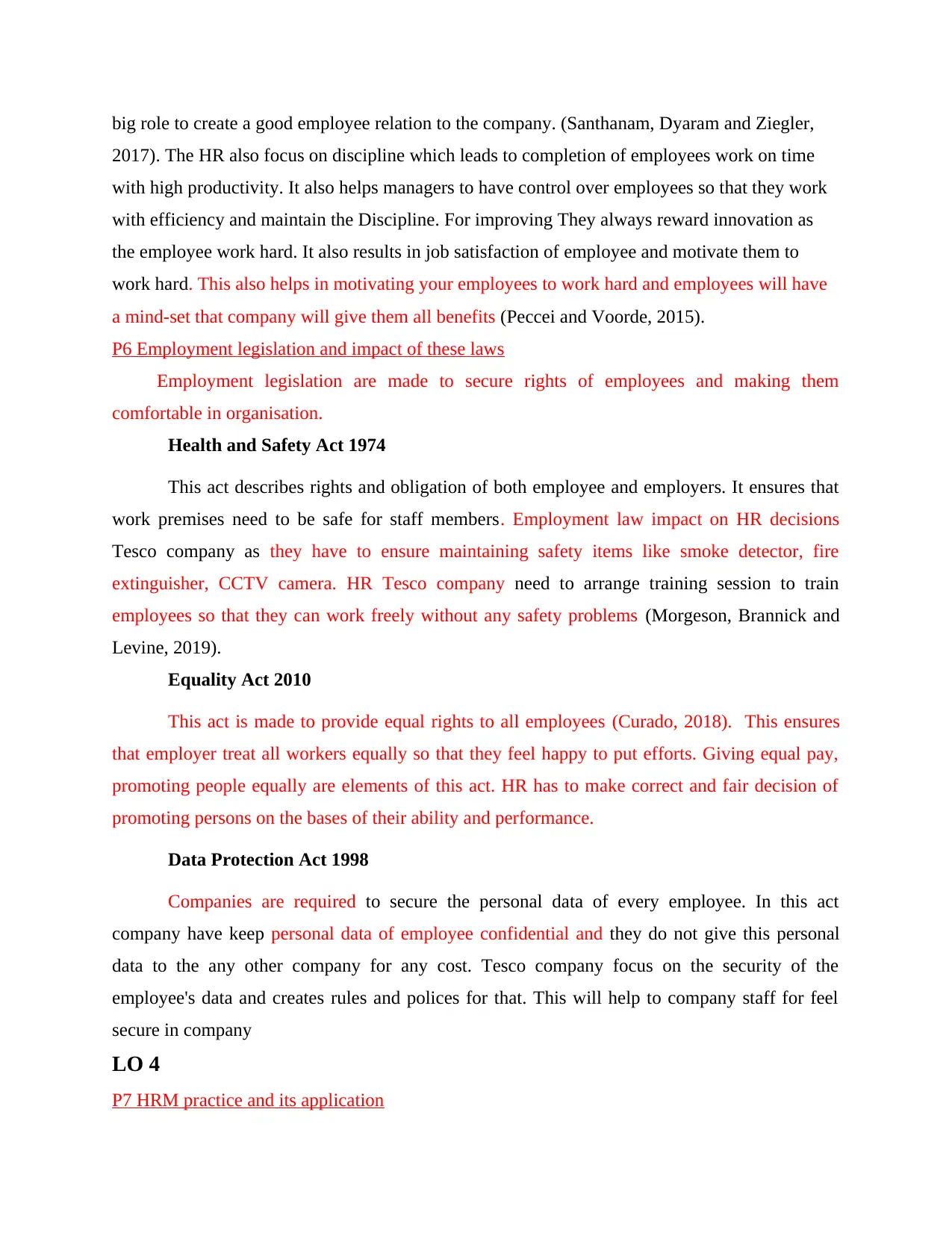
big role to create a good employee relation to the company. (Santhanam, Dyaram and Ziegler,
2017). The HR also focus on discipline which leads to completion of employees work on time
with high productivity. It also helps managers to have control over employees so that they work
with efficiency and maintain the Discipline. For improving They always reward innovation as
the employee work hard. It also results in job satisfaction of employee and motivate them to
work hard. This also helps in motivating your employees to work hard and employees will have
a mind-set that company will give them all benefits (Peccei and Voorde, 2015).
P6 Employment legislation and impact of these laws
Employment legislation are made to secure rights of employees and making them
comfortable in organisation.
Health and Safety Act 1974
This act describes rights and obligation of both employee and employers. It ensures that
work premises need to be safe for staff members. Employment law impact on HR decisions
Tesco company as they have to ensure maintaining safety items like smoke detector, fire
extinguisher, CCTV camera. HR Tesco company need to arrange training session to train
employees so that they can work freely without any safety problems (Morgeson, Brannick and
Levine, 2019).
Equality Act 2010
This act is made to provide equal rights to all employees (Curado, 2018). This ensures
that employer treat all workers equally so that they feel happy to put efforts. Giving equal pay,
promoting people equally are elements of this act. HR has to make correct and fair decision of
promoting persons on the bases of their ability and performance.
Data Protection Act 1998
Companies are required to secure the personal data of every employee. In this act
company have keep personal data of employee confidential and they do not give this personal
data to the any other company for any cost. Tesco company focus on the security of the
employee's data and creates rules and polices for that. This will help to company staff for feel
secure in company
LO 4
P7 HRM practice and its application
2017). The HR also focus on discipline which leads to completion of employees work on time
with high productivity. It also helps managers to have control over employees so that they work
with efficiency and maintain the Discipline. For improving They always reward innovation as
the employee work hard. It also results in job satisfaction of employee and motivate them to
work hard. This also helps in motivating your employees to work hard and employees will have
a mind-set that company will give them all benefits (Peccei and Voorde, 2015).
P6 Employment legislation and impact of these laws
Employment legislation are made to secure rights of employees and making them
comfortable in organisation.
Health and Safety Act 1974
This act describes rights and obligation of both employee and employers. It ensures that
work premises need to be safe for staff members. Employment law impact on HR decisions
Tesco company as they have to ensure maintaining safety items like smoke detector, fire
extinguisher, CCTV camera. HR Tesco company need to arrange training session to train
employees so that they can work freely without any safety problems (Morgeson, Brannick and
Levine, 2019).
Equality Act 2010
This act is made to provide equal rights to all employees (Curado, 2018). This ensures
that employer treat all workers equally so that they feel happy to put efforts. Giving equal pay,
promoting people equally are elements of this act. HR has to make correct and fair decision of
promoting persons on the bases of their ability and performance.
Data Protection Act 1998
Companies are required to secure the personal data of every employee. In this act
company have keep personal data of employee confidential and they do not give this personal
data to the any other company for any cost. Tesco company focus on the security of the
employee's data and creates rules and polices for that. This will help to company staff for feel
secure in company
LO 4
P7 HRM practice and its application
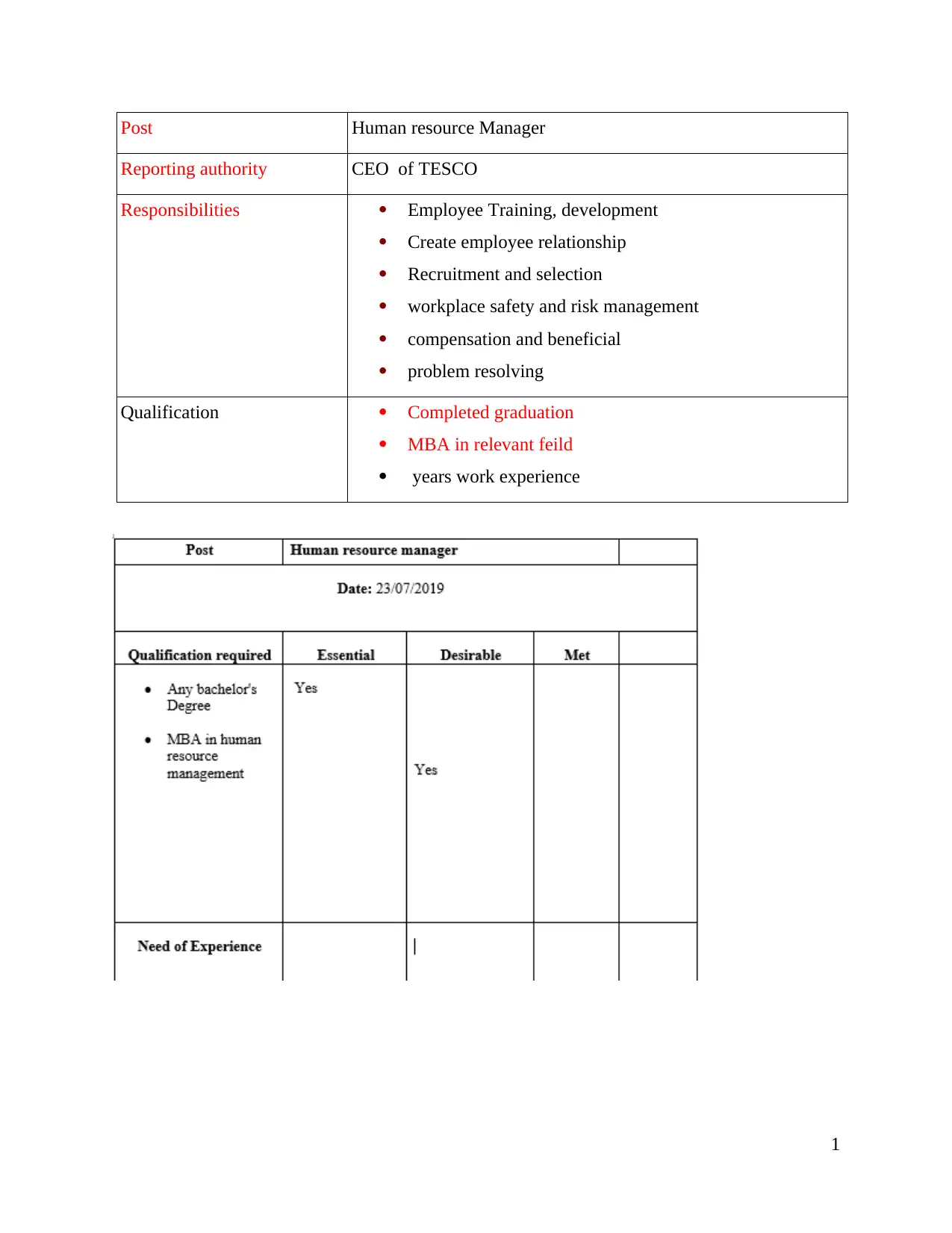
Post Human resource Manager
Reporting authority CEO of TESCO
Responsibilities Employee Training, development
Create employee relationship
Recruitment and selection
workplace safety and risk management
compensation and beneficial
problem resolving
Qualification Completed graduation
MBA in relevant feild
years work experience
1
Reporting authority CEO of TESCO
Responsibilities Employee Training, development
Create employee relationship
Recruitment and selection
workplace safety and risk management
compensation and beneficial
problem resolving
Qualification Completed graduation
MBA in relevant feild
years work experience
1
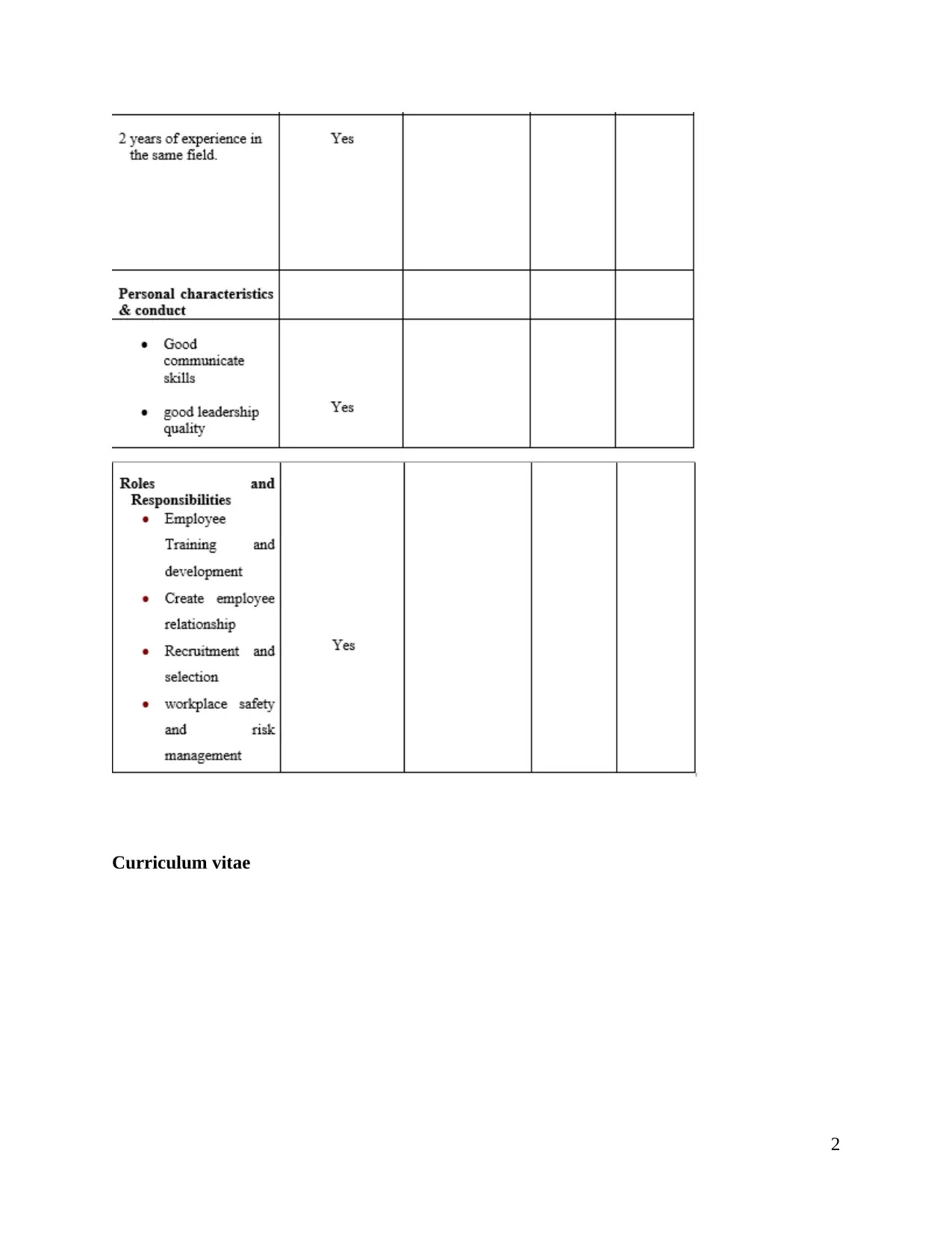
Curriculum vitae
2
2
Secure Best Marks with AI Grader
Need help grading? Try our AI Grader for instant feedback on your assignments.
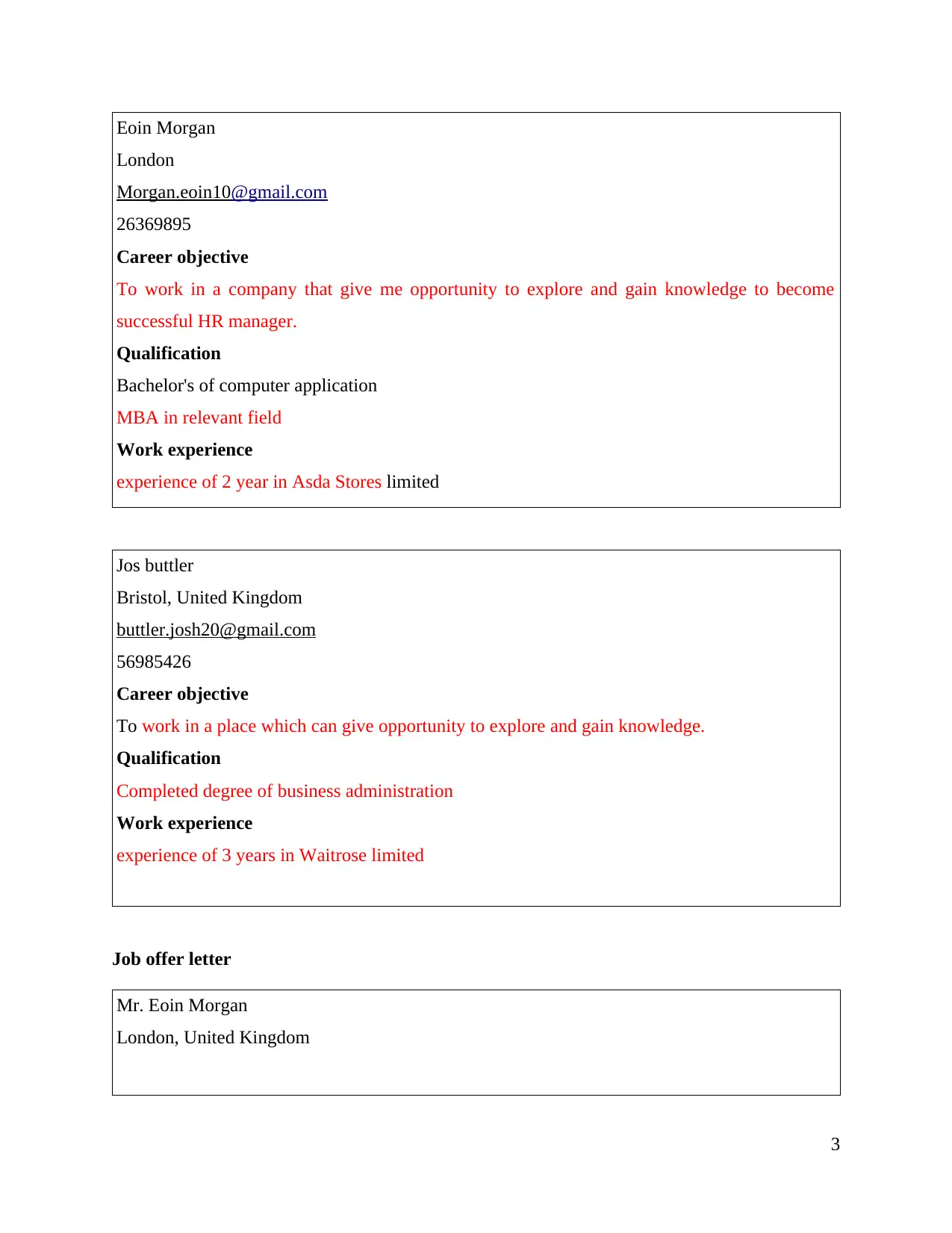
Eoin Morgan
London
Morgan.eoin10@gmail.com
26369895
Career objective
To work in a company that give me opportunity to explore and gain knowledge to become
successful HR manager.
Qualification
Bachelor's of computer application
MBA in relevant field
Work experience
experience of 2 year in Asda Stores limited
Jos buttler
Bristol, United Kingdom
buttler.josh20@gmail.com
56985426
Career objective
To work in a place which can give opportunity to explore and gain knowledge.
Qualification
Completed degree of business administration
Work experience
experience of 3 years in Waitrose limited
Job offer letter
Mr. Eoin Morgan
London, United Kingdom
3
London
Morgan.eoin10@gmail.com
26369895
Career objective
To work in a company that give me opportunity to explore and gain knowledge to become
successful HR manager.
Qualification
Bachelor's of computer application
MBA in relevant field
Work experience
experience of 2 year in Asda Stores limited
Jos buttler
Bristol, United Kingdom
buttler.josh20@gmail.com
56985426
Career objective
To work in a place which can give opportunity to explore and gain knowledge.
Qualification
Completed degree of business administration
Work experience
experience of 3 years in Waitrose limited
Job offer letter
Mr. Eoin Morgan
London, United Kingdom
3
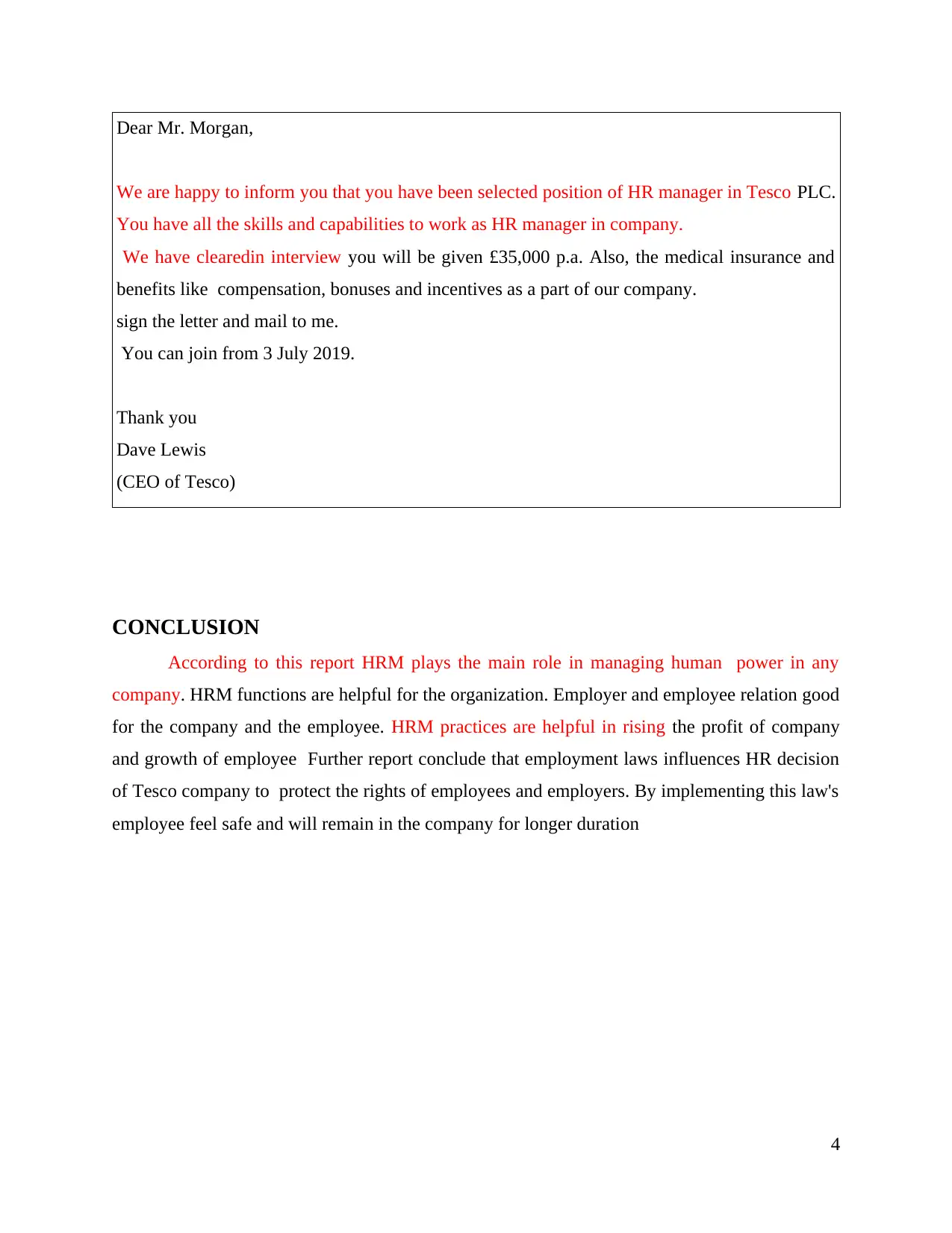
Dear Mr. Morgan,
We are happy to inform you that you have been selected position of HR manager in Tesco PLC.
You have all the skills and capabilities to work as HR manager in company.
We have clearedin interview you will be given £35,000 p.a. Also, the medical insurance and
benefits like compensation, bonuses and incentives as a part of our company.
sign the letter and mail to me.
You can join from 3 July 2019.
Thank you
Dave Lewis
(CEO of Tesco)
CONCLUSION
According to this report HRM plays the main role in managing human power in any
company. HRM functions are helpful for the organization. Employer and employee relation good
for the company and the employee. HRM practices are helpful in rising the profit of company
and growth of employee Further report conclude that employment laws influences HR decision
of Tesco company to protect the rights of employees and employers. By implementing this law's
employee feel safe and will remain in the company for longer duration
4
We are happy to inform you that you have been selected position of HR manager in Tesco PLC.
You have all the skills and capabilities to work as HR manager in company.
We have clearedin interview you will be given £35,000 p.a. Also, the medical insurance and
benefits like compensation, bonuses and incentives as a part of our company.
sign the letter and mail to me.
You can join from 3 July 2019.
Thank you
Dave Lewis
(CEO of Tesco)
CONCLUSION
According to this report HRM plays the main role in managing human power in any
company. HRM functions are helpful for the organization. Employer and employee relation good
for the company and the employee. HRM practices are helpful in rising the profit of company
and growth of employee Further report conclude that employment laws influences HR decision
of Tesco company to protect the rights of employees and employers. By implementing this law's
employee feel safe and will remain in the company for longer duration
4
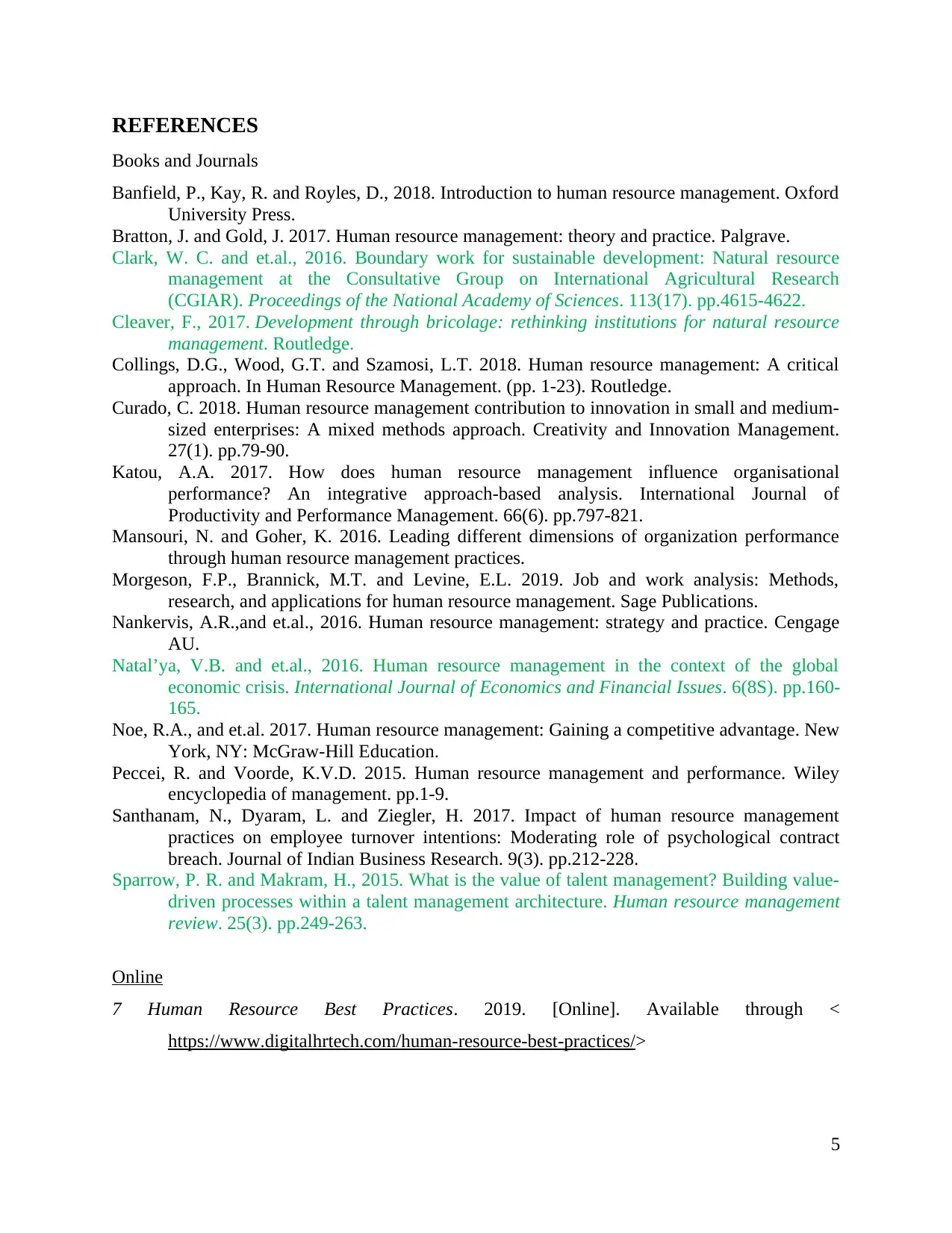
REFERENCES
Books and Journals
Banfield, P., Kay, R. and Royles, D., 2018. Introduction to human resource management. Oxford
University Press.
Bratton, J. and Gold, J. 2017. Human resource management: theory and practice. Palgrave.
Clark, W. C. and et.al., 2016. Boundary work for sustainable development: Natural resource
management at the Consultative Group on International Agricultural Research
(CGIAR). Proceedings of the National Academy of Sciences. 113(17). pp.4615-4622.
Cleaver, F., 2017. Development through bricolage: rethinking institutions for natural resource
management. Routledge.
Collings, D.G., Wood, G.T. and Szamosi, L.T. 2018. Human resource management: A critical
approach. In Human Resource Management. (pp. 1-23). Routledge.
Curado, C. 2018. Human resource management contribution to innovation in small and medium‐
sized enterprises: A mixed methods approach. Creativity and Innovation Management.
27(1). pp.79-90.
Katou, A.A. 2017. How does human resource management influence organisational
performance? An integrative approach-based analysis. International Journal of
Productivity and Performance Management. 66(6). pp.797-821.
Mansouri, N. and Goher, K. 2016. Leading different dimensions of organization performance
through human resource management practices.
Morgeson, F.P., Brannick, M.T. and Levine, E.L. 2019. Job and work analysis: Methods,
research, and applications for human resource management. Sage Publications.
Nankervis, A.R.,and et.al., 2016. Human resource management: strategy and practice. Cengage
AU.
Natal’ya, V.B. and et.al., 2016. Human resource management in the context of the global
economic crisis. International Journal of Economics and Financial Issues. 6(8S). pp.160-
165.
Noe, R.A., and et.al. 2017. Human resource management: Gaining a competitive advantage. New
York, NY: McGraw-Hill Education.
Peccei, R. and Voorde, K.V.D. 2015. Human resource management and performance. Wiley
encyclopedia of management. pp.1-9.
Santhanam, N., Dyaram, L. and Ziegler, H. 2017. Impact of human resource management
practices on employee turnover intentions: Moderating role of psychological contract
breach. Journal of Indian Business Research. 9(3). pp.212-228.
Sparrow, P. R. and Makram, H., 2015. What is the value of talent management? Building value-
driven processes within a talent management architecture. Human resource management
review. 25(3). pp.249-263.
Online
7 Human Resource Best Practices. 2019. [Online]. Available through <
https://www.digitalhrtech.com/human-resource-best-practices/>
5
Books and Journals
Banfield, P., Kay, R. and Royles, D., 2018. Introduction to human resource management. Oxford
University Press.
Bratton, J. and Gold, J. 2017. Human resource management: theory and practice. Palgrave.
Clark, W. C. and et.al., 2016. Boundary work for sustainable development: Natural resource
management at the Consultative Group on International Agricultural Research
(CGIAR). Proceedings of the National Academy of Sciences. 113(17). pp.4615-4622.
Cleaver, F., 2017. Development through bricolage: rethinking institutions for natural resource
management. Routledge.
Collings, D.G., Wood, G.T. and Szamosi, L.T. 2018. Human resource management: A critical
approach. In Human Resource Management. (pp. 1-23). Routledge.
Curado, C. 2018. Human resource management contribution to innovation in small and medium‐
sized enterprises: A mixed methods approach. Creativity and Innovation Management.
27(1). pp.79-90.
Katou, A.A. 2017. How does human resource management influence organisational
performance? An integrative approach-based analysis. International Journal of
Productivity and Performance Management. 66(6). pp.797-821.
Mansouri, N. and Goher, K. 2016. Leading different dimensions of organization performance
through human resource management practices.
Morgeson, F.P., Brannick, M.T. and Levine, E.L. 2019. Job and work analysis: Methods,
research, and applications for human resource management. Sage Publications.
Nankervis, A.R.,and et.al., 2016. Human resource management: strategy and practice. Cengage
AU.
Natal’ya, V.B. and et.al., 2016. Human resource management in the context of the global
economic crisis. International Journal of Economics and Financial Issues. 6(8S). pp.160-
165.
Noe, R.A., and et.al. 2017. Human resource management: Gaining a competitive advantage. New
York, NY: McGraw-Hill Education.
Peccei, R. and Voorde, K.V.D. 2015. Human resource management and performance. Wiley
encyclopedia of management. pp.1-9.
Santhanam, N., Dyaram, L. and Ziegler, H. 2017. Impact of human resource management
practices on employee turnover intentions: Moderating role of psychological contract
breach. Journal of Indian Business Research. 9(3). pp.212-228.
Sparrow, P. R. and Makram, H., 2015. What is the value of talent management? Building value-
driven processes within a talent management architecture. Human resource management
review. 25(3). pp.249-263.
Online
7 Human Resource Best Practices. 2019. [Online]. Available through <
https://www.digitalhrtech.com/human-resource-best-practices/>
5
1 out of 13
Related Documents
Your All-in-One AI-Powered Toolkit for Academic Success.
+13062052269
info@desklib.com
Available 24*7 on WhatsApp / Email
![[object Object]](/_next/static/media/star-bottom.7253800d.svg)
Unlock your academic potential
© 2024 | Zucol Services PVT LTD | All rights reserved.





